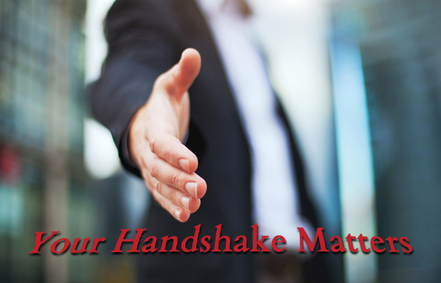Back in 1998 I was one of thirty press people who spent the day with His Holiness the Dalai Lama in Pittsburgh. One of the press people asked His Holiness what he felt the purpose of life was. His Holiness replied “To be happy. Not happy at the expense of another but truly happy within your being. When you are truly happy within your being you are happy to help others in any way you can.” His response really hit me at that time and continues to be a mantra for me to this day.
|
Last week I talked about the importance of a good handshake. This week I would like to continue to address the handshake and some concerns around it. A family member, who is also a doctor, gave me a copy of his JAMA (Journal of the American Medical Association) newsletter. One of the articles he wanted me to see was all about the handshake and the significant role it plays in transmitting disease.
First, let’s take a look at this social custom which is ingrained in so many, but by no means all, cultures. It is believed that the handshake started as a gesture of goodwill with the Greeks—revealing one’s open palm conveyed trust and the fact that no weapon was hidden. This open palm gesture evolved over time to what we see today as the handshake. It is used for greetings, to show respect, congratulations, used when departing one’s company, used to solidify formal agreements and more. There was a time when a person’s word and their handshake was all that was needed to seal a deal. While there may be many other forms of greeting around the world, in the world of business the handshake is still primarily the gesture that binds the agreement. I don’t know why I am continually amazed when I get a bad handshake. While there are countries in the world where a handshake is not appropriate, in the vast majority of the world it is the accepted form of greeting someone. In the business world, it is not only the accepted form of greeting but it is also used to close a deal or to say goodbye.
We’ve all heard that it takes only 7 seconds to make an image impact, but it may be far less than that according to a series of experiments done by Princeton psychologists, Janine Willis and Alexander Todorov. According to their findings, it only takes 1/10th of a second to form an impression about someone and those impressions are not significantly altered. If this is true, your handshake becomes even more important than ever. We’ve all seen and heard incredibly dull and confusing presentations. While business topics can often be dry, they don’t need to be boring. We all dream of being entertaining, informative, empowering and inspiring speakers. While some may be more riveting than others, it is possible to come very close to achieving the mark if you’re careful not to fall into certain traps. There are 10 common mistakes that people make when presenting that if corrected can amp up your presentation skills significantly. Let’s take a look at some of the most common mistakes presenters make. 1. Failing to Prepare Properly and Rehearse Enough Failing to prepare really is preparing to fail. This is probably the most common mistake I see and yet so easy to overcome. Steve Jobs was a master at making his presentations look easy and relaxed. The reason they looked this way is because he took weeks to prepare and rehearse them. You can never be too prepared. The more prepared you are, the more relaxed, spontaneous and conversational you’ll appear. Being properly prepared is one of the ways you ease nervous tension as well. Albert Mehrabian did a study and found that when two strangers meet, the one who was the most relaxed was perceived by both parties as being the one with the higher stature. It is imperative to be relaxed when you are presenting. Being prepared will help you know your material inside and out and will help you in the relaxation arena. Fill out the form below to download a copy of our Persuasive Model Outline so that you can be better prepared. 2. Not Knowing the Venue
|
|







